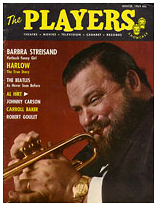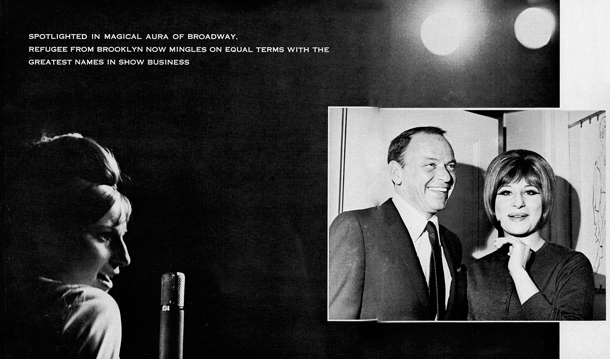
Players Magazine
Winter 1965
PRODUCING THE STREISAND STORY
IN TWO PARTS, PLAYERS SHOWCASE
PRESENTS ACT ONE—THE JOURNEY
FROM FLATBUSH TO "FUNNY GIRL".
Part One | Part Two
Barbra — Born Loser Wins Broadway
by David Henderson

TO A SENSITIVE EAR, the most bittersweet instruments of music in the world are the harp, the lute, and the vocal cords of Barbra Streisand. Her voice already is a living legend wherever it has been heard, and particularly on Broadway, where her portrayal of Fanny Brice in Funny Girl has been electrifying wall-to-wall audiences ever since the show opened to laudatory reviews last March.
Yet, her voice is no more legendary than her personality. There is, for example, the story of her first Funny Girl rehearsal, when many members of the cast caught their initial glimpse of the copper-haired, 21-year-old star. Director Garson Kanin wanted Barbra to try out one of the show's songs, although she scarcely had glanced at the score the night before. Nonchalantly, Barbra took her wad of chewing gum out of her mouth, dropped it into Kanin's hand, and sang. She bit into the heart of the song with the same intensity she had been using on her gum and, when she finished, she received a long and hearty ovation from the cast and crew—from everyone, that is, except Kanin, who waited, reasonably enough, until Barbra had taken back her gum.
Such stories delight Streisand's fans, whether they are monarchs of society or middle-class urbanites, but for different reasons. The aristocrats are fascinated by Barbra's "kook" qualities in much the same way they are fascinated by quaintness and originality in an antique teapot.
The commoners, however, dig the Streisand personality because— contrary to being a kook—Barbra comes across very real. She is the down-to-earth essence of all those little people in her Brooklyn background—the butchers, dressmakers, cabbies, and fruit peddlers. And there she is—a Jewish Cinderella, as ordinary-looking as a loaf of pumpernickel—up there in the never-never land of show business, winning thunderous acclaim from the whole cross section of the United States, and even—at one time—from, the late President John F. Kennedy.
To the herds of common people, Barbra is the eternal underdog who fought from tears to triumph, proving that it still can be done. Now, wandering through the celestial heights of fame and fortune, she has acquired beauty on top of everything else. Not quite the gaudy, fragile beauty usually associated with performers, but more the kind of beauty described in 610 B.C. by the Greek poetess, Sappho: "What is beautiful is good, and who is good will soon be beautiful."
This, perhaps, is a strange way to describe a super-celebrity, but Barbra is a strange entry in the tinseled universe of show business. She lacks sophistication. She is uncomfortable at gatherings of the elite. She has refused to have her nose bobbed, or to wear slinky gowns and trussed underwear. "I'm me," she says, "and that's all there is." If it were hot for her tremendous talent, she would be a fish out of water.

Her nonconformity, her refreshing candor, are best expressed in her own words, as quoted here from a column she wrote for the New Yorf Journal-American: "What fascinates me are can openers and magnetic pot holders. What imagination! Who could have thought of things like that? Apple-corers! What's so fantastic about bombs? It's a grapefruit knife—that's genius . . .
"It was fun to steal. Things seemed so much more valuable. It was not just the package of gum I stole, but also the wrapper, the joke inside, the colors, the printing. Boy, oh boy!
"I love pigs. I'm mad for pigs. Anything that's shaped like a pig. I like penguins, too. They're great . . .
"Wire hangers and window shades are very frightening . . .
"I hate diamonds. I like garnets, jade, emeralds, and rubies in old settings. Interviews are weird. By the time they appear in print they look funny to me, because my attitude changes from week to week. In fact, now I love diamonds! ...
"Success is nice in many ways, but there's one thing I don't like about it. People recognize me now. It's hard to steal."
Even if you do not take her seriously, could you imagine such sentiments expressed by the likes of Mary Martin, Julie Andrews, Ethel Merman, or any of the other greats of Broadway?
It is equally typical of Barbra's Brooklyn personality that she never realized the whopping potential of her voice until it was earning her $5000 a week. "This singing bit," she says, "just happened, you know. I'm an actress."

Acting had been Barbra's blazing desire throughout her moody childhood. Her father died when she was a child, and her mother remarried. By the time Barbra was in her teens, an honor student at Erasmus Hall High School, she could think of nothing else but fame and success as a movie or theatrical star, if for no other reason but to escape from Brooklyn. "I lived with my mother in Brooklyn until I left high school," she says, "and in all that time I never had a room of my own—I slept on a couch. Ever sleep on a couch night after night? All you think about is, 'How can I get a room of my own?' You just get to the point where you have to make good!"
After graduation, Barbra moved to Manhattan, taking temporary housing in the apartments of friends, lugging around a portable cot upon which to sleep. For a time, she studied with Alan Miller, a drama coach, whose fondest recollection of Barbra is the improvisation she did of a chocolate chip melting in an oven. But when she made the rounds of casting offices, she repeatedly struck the wrong chord. "It was winter," she says. "I was wearing heavy black tights. People looked at me as though I was nuts. I'd say, 'Look, you'd better sign me up. I'm terrific.' But they wouldn't let me read. How can they tell anything if they won't let you read?"
Unable to worm her way into the theatre, Barbra turned temporarily to singing. She had no formal voice training, and she could not read music. (She still can't.) All she had was a set of vocal cords by Stradivarius and a sound so vibrantly rich that—in the words of J. S. Knowles—"there's nothing lives 'twixt it and silence." Needing money for food, clothing and rent—she had found herself a cheap, smelly apartment above an East Side fish restaurant—Barbra decided to enter a small talent contest at The Lion, a bar and restaurant in Greenwich Village. The customers laughed when she got up to sing. It was the first time she ever had been in a night club, or anything resembling one, and she was wearing her now-famous thrift-shop clothes which sagged from her willowy frame like a war-surplus army tent. But when she finished her renditions of "When Sunny Gets Blue" and "A Sleepin' Bee," there was no more contest. Those lucky few who saw her professional debut and heard for the first time how this rejected actress was able to emote through the lyrics, turning the simplest tunes into powerful playets, say today: "She had to be a great star. You could see stardom all over her." Barbra won first prize— $50 and a brief singing engagement at the bar. From then on, her ride to the top was absolutely breath-taking.
She auditioned at the Bon Soir, another nightclub in Greenwich Village. She asked to be introduced as a native of Smyrna, Turkey. When she stepped up to the microphone, she let out a shattering scream to get everyone's attention, then calmly took her gum out of her mouth, stuck it to the mike, and sang "Who's Afraid of the Big Bad Wolf?"
Her stint at the Bon Soir lasted for 10 weeks at $125 a week. Next came an appearance at the Blue Angel downtown, a club famous as a showcase of new talent. To midtown sophisticates, the Streisand sound was a brand new experience. She wore clothes which were—to say the least— unconventional. "Some stories make it sound like I used to be an outrageous ragamuffin," she wrote recently in the New York Herald Tribune, "and now I wear only designer fashions. But that's why thrift shops fascinated me. There you could buy designer clothes for a song—good thing I sing. Maybe they were last season's, or 20 seasons ng-o—but they were beautiful originals. They became even more original, 'because in altering them to fit me, I might change a neckline or add beading."
Standing in the spotlights at the Blue Angel, clad in vests, A-line skirts, buckled shoes, and with her hair styled like Lon Chaney's, Barbra thoroughly disarmed her audiences even before she opened her mouth. And when she sang, the roof caved in. "You better not shout, you better not cry, you better not, pout, I'm telling you why— Santa Claus is dead!" Or, "The hills are alive . . . and it's pretty frightening!" But when she got around to serious music, she sang "Happy Days Are Here Again" as though it were the national anthem.
One such performance at the Blue Angel was witnessed by producer David Merrick, who arranged for Barbra to audition for his new musical production of Jerome Weidman's I Can Get It for You Wholesale. "I sang," recalls Barbra in a Header's Digest story, "and then I sort of ran around the stage yelling my phone number and saying: 'Wow! Will somebody call me, please? Even if I don't get the part, just call!' I'd gotten my first phone that day, and I was wild to get calls on it."
She did get a call that night. Someone said, "You were brilliant," and then hung up.

The mysterious, shy voice, it turned out, belonged to Elliott Gould, the star of Wholesale. Actually, he was not the only one who had been impressed by Barbra's audition; Jerome Weidman says, "When we heard this kid, she just knocked us off our ears." But Gould was impressed by more than Barbra's performance, and after she won the part of the harassed secretary, Miss Marmelstein, he began walking her to the subway after rehearsals.
One night after a date, they were walking around the skating rink at Rockefeller Center when it started to snow. "We had a snow fight," Barbra, says. "He never held me around or anything, but he put snow on my face and kissed me. It sounds so icky, but it was great—like out of a movie."
Thus, it was in typical storybook fashion that Barbra landed a role in her first major musical, stole the whole show, and fell in love with—and married—the star. She was destiny's tot, and now the heights were in sight.
Barbra's show song, "Miss Marmelstein," was the highlight of Columbia's original cast album from Wholesale; so Columbia decided that Barbra was worth recording on her own. Her first disk, The Barbra Streisand Album, immediately went on the charts among the best-sellers in the recording industry and soon was joined in that lofty atmosphere by The Second Barbra Streisand Album. An appearance on a Dinah Shore special introduced her to a nation of TV viewers and to the late President Kennedy, who invited her to entertain at the White House.
Her coast-to-coast nightclub and concert tours were totally triumphant. Columbia recorded Barbra Streisand/The Third Album, another hit. And then came Funny Girl.
At the Winter Garden theatre, on the same stage where Fanny Brice made her last Broadway appearance as Baby Snooks in the Follies of 1933, Barbra Streisand today gazes into a mirror and pronounces, "I'm gorgeous!" And everyone has to agree.
Critics still are leafing through their copies of Koget's Thesaurus, searching for new words to describe this immense talent. Besides creating temples in sound, she brings to the stage a dazzling presence that is almost spiritual. Her glissading movements, her polyphonic voice, her touching expressions, combine in a concert of sight and sound that shifts from humoresque to capriccioso to pastorale. It is as though Euterpe herself were on the Broadway stage, showing us mere mortals how it should be done. And out of this success have come two more hit records—the original cast album from Funny Girl by Capitol, and Columbia's People.
And yet, offstage, Barbra turns back into a peppermint stick. She passes shyly through the huddled crowd of fans who wait for her at the stage door, goes home to her new Manhattan apartment where she and Elliott live among a vast, collage of velvet and herringbone fabrics, spoons herself out a dish of coffee ice cream, and plops down on her huge, 300-year-old canopied and draped bed, and watches monster movies on television. Perhaps, when the lights are off, she may wonder if she will awaken in the morning back on a couch in Brooklyn.
And then, there is that nagging question: now that she has the moon, what does she do for an encore?
(EDITOR NOTE : That question, and many others, will be answered in the interview The PLAYERS Showcase has scheduled for the next issue, when we continue with Part Two of the Barbra Streisand Story).
